![]() May 4, 2024
May 4, 2024
![]() 7534
7534
![]() 0
0
Energy demand is rising, leading to dependence on fossil fuels like coal, oil, and gas. This reliance raises concerns about energy security and environmental issues. To address this, renewable sources like solar, wind, tide, biomass, and waste energy are crucial. India, with abundant sunlight, water, wind, and biomass, has significant renewable energy potential.

| Monazite contains rare earth elements and thorium; India possesses the world’s largest monazite reserves in the beach sands along the coast of Kerala and Tamil Nadu; Only Government bodies can process and export monazite; Uranium is found in igneous and metamorphic rocks in India [UPSC 2022] |
| Must Read | |
| Current Affairs | Editorial Analysis |
| Upsc Notes | Upsc Blogs |
| NCERT Notes | Free Main Answer Writing |
Conclusion
| Related Articles | |
| Non-Conventional Energy: Definition, Sources, Potential, Growth | River Systems of India |
| National Bioenergy Programme (NBP) | Energy Transition |
<div class="new-fform">
</div>
Latest Comments